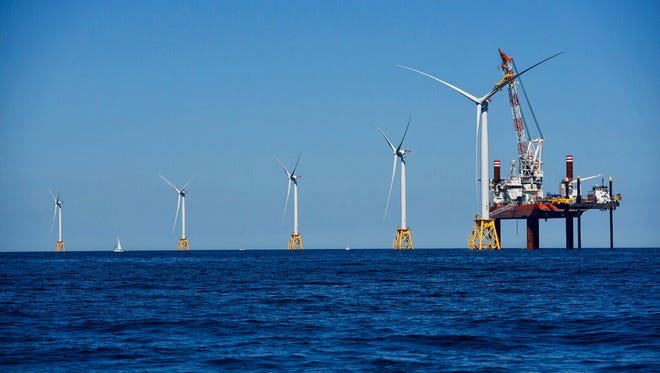Offshore wind farms near reality for Delmarva

Two offshore wind companies are making renewable energy a reality off Delmarva's coast.
Deepwater Wind and US Wind have proposals in review by the Maryland Public Service Commission for a wind farm about 19 miles off the coast of Ocean City.
Offshore wind is not only feasible, but the logical choice for future sustainable energy for the highly populated East Coast, said Jeff Grybowski, CEO of Deepwater, which is based in Providence, Rhode Island.
"We're talking about an area, from D.C. up through the north, that is highly populated, but does not have the land area for large scale solar operations, or on shore wind farms," Grybowski. "It's very practical."
Grybowski also said construction of the wind farms is simplified by the continental shelf, which, at the area of construction of the proposed "Skipjack" project, holds an ocean depth of approximately 100 feet, easing the construction process.
"That's fairly shallow when we're talking about the ocean," Grybowski said.
Deepwater, known for the Block Island project in Rhode Island, the first offshore wind farm in the United States, is planning on construction of a modestly sized wind farm located in federal water about 17 nautical miles off the coast of Ocean City. Purchased at auction from the Department of Interior, the 96,000 acre area of ocean will host a 120 megawatt-capable farm, consisting of 20 separate six-megawatt turbines.
"In those first phases, we're looking at supplying about 1 percent of power to the state of Maryland," Deepwater Vice President Clint Plummer said.
The Deepwater Plan is modular, expected to grow with time and start with humble size. In comparison, the Baltimore-based US Wind company has a plan that is a bit more ambitious, aiming for a 750-megawatt plant, consisting of 187 turbines, in a 125 square-mile plot off the coast of Ocean City.
US Wind Director of Project Development Paul Rich speculated the project could account for approximately 7.5 percent of the state's total energy load.

READ MORE: OC offshore wind project seeking government backing
Rich also said the new offshore energy industry would be invaluable for job production across the state of Maryland.
"We're looking at 60 to 80 good paying, annual jobs with benefits coming to Ocean City, along with the production end in Baltimore for this project," Rich said. "People are seeing the economic and job creation value of this industry, and they're eager to see it up and running."
Offshore wind farms, while prominent in Europe since the 1990s, have nonetheless received scrutiny from, both cost and environmental standpoints. While Grybowski and Rich both could not state the exact kilowatt-hour cost for the wind farms, the Maryland Public Service Commission, as part of the approval process, has required proposals to be cost-effective for the rate payers.
That could prove difficult. In Rhode Island, natural gas composes 95 percent of the electric grid, with a kilowatt hour costs well above the national average, at 18.57 cents compared to 12.9 cents, according to the US Energy Information Administration.
In Maryland, where nuclear, the pound-for-pound cheapest source of electricity at just over two cents per kilowatt hour, composes 40 percent of the state's energy generation, electricity is significantly cheaper, at 13.83 cents per kilowatt hour.
Grybowski said while unable to disclose details, the Public Service Commission has found their projections to be well below any competitor.
"The technology is constantly changing and growing," Grybowski said. "What was possibly too expensive, with technological advances becomes more and more possible."
READ MORE: Maryland reviewing proposals for offshore windmills
The Maryland Public Service Commission has placed a cap on the cost of offshore wind at $190 per megawatt hour, or 19 cents per kilowatt hour, as stated in the Maryland Offshore Energy Wind Act of 2013.
For environmentalists, the project proposals are looked at cautiously.
Roman Jesien, a scientist with the Maryland Coastal Bays Program, said he's concerned for the well-being of migratory animals during the construction of the wind farms.
"That's one of our concerns, that these sensitive areas are not disrupted by industrial construction projects," Jesien said.
Grybowski, Plummer and Rich all said proper surveying and radar protocol are carried out to protect marine and avian life.
The proposals for both the US Wind and Deepwater projects are currently in review by the Public Service Commission, a process planned for 180 days as of Friday, Nov. 18.